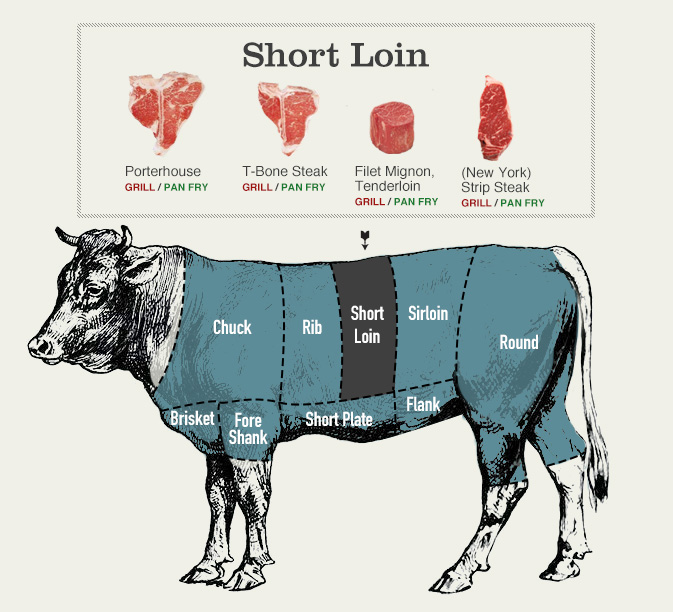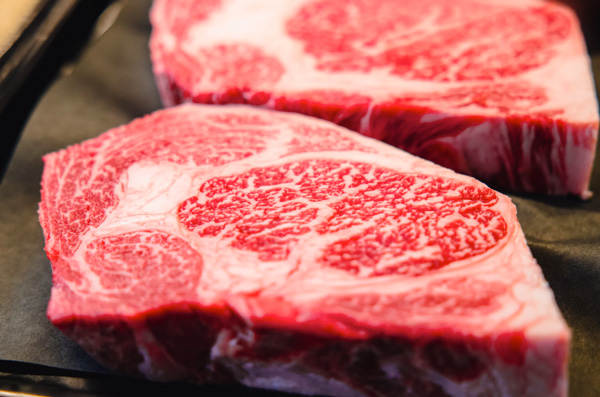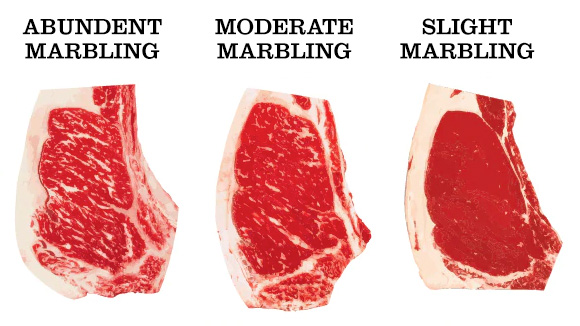All beef, no bull–read this before cooking your next steak.
Beef. It’s a staple of the American diet, a delicious dish that humans have enjoyed in one form or another since prehistoric times. And now that you’re no longer pursuing your dinner across a vast grassy plain, you can afford to be a bit choosy about which cut of beef you choose to grill, roast, or perhaps reverse sear (an all-time Primer favorite technique).
But unlike chicken or pork, ordering or buying and cooking beef can be a bit overwhelming. There are easily more than a dozen cuts of beef. You’ve probably heard of many of them–especially the popular steakhouse cuts like porterhouse, T-bone, New York strip, and sirloin. But do you know what differentiates tri-tip from flank steak? Or why to order–or how to cook–either of them?
The next time you’re in the mood for a steak dinner, do yourself (and any guests) a favor and familiarize yourself with the most common cuts of beef, what they’re good for, and the best way to cook each one. For example, don’t assume that you have to buy pricey filet mignon in order to have the best tasting, most flavorful meal. Prepared correctly, any of these cuts will be delicious.
To create this guide, I consulted with Lou from the famous Marconda’s butcher shop, right here at the Los Angeles Farmer’s Market. Family owned since 1941, Marconda’s knows a thing or two about beef. (Pro tip: if you want to get the best quality beef, seek out a local butcher.)
Understanding Beef Rib Cuts
Ribeye
Along with the porterhouse, Lou notes that this is one of the top two cuts of beef. Ribeye combines great flavor and texture, thanks to a marbling of fat that helps it stay tender during cooking. Looking to impress your date with a steak dinner? The ribeye is your cut.
Short Ribs
Larger and meatier than pork ribs, beef short ribs may require long cooking times but are virtually impossible to mess up. And when done properly, the meat will slide off the bones. To create a restaurant-quality meal at home, try Galbi, or Korean-style short ribs. The soy sauce-based marinade traditionally contains brown sugar and pear, which helps caramelize the meat to savory-sweet perfection.
Prime Rib, Rib Roast
The term prime rib is more likely to be seen in a restaurant than at the butcher’s counter. To be prime rib, it must be a rib roast from the most desirable part of the rib section. The flavor is closer to roast beef than a steak.
Back Ribs
Well-marbled with fat, these are the bones the ribeye comes off of. Beef ribs can be chewy if not prepared correctly – flavorful and tender ribs take a few hours to cook.
Beef Short Loin Cuts

Porterhouse
Cut from the rear end of the loin, this cut of beef features two steaks, connected by a T-shaped bone: the larger strip steak, which packs a flavorful punch, and the smaller, incredibly tender filet mignon. Along with the ribeye, this is one of Lou’s top two steaks.
T-Bone Steak
Nearly identical to the porterhouse, the T-bone is cut farther forward on the loin and includes less of the filet mignon. This can help you decide which you want to eat, depending on whether flavor or texture is more important to you. Along with the porterhouse, the T-bone is considered one of the highest quality steaks and is a steakhouse staple.
(New York) Strip Steak
A strip steak is the half of a porterhouse or T-bone without the filet mignon. Cut from a little-used muscle on the loin, this steak is particularly tender–though less so than the filet mignon or ribeye.
Filet Mignon, Tenderloin
The tenderloin is a narrow strip of tender meat that spans the loin and sirloin beneath the ribs next to the backbone. When cut into individual portions, it’s sold as Filet Mignon. One of the most tender cuts on the beast, it makes up half of a porterhouse or T-Bone steak. Some find that while it excels in tenderness, it lacks that robust beefy flavor.
Sirloin

Tri-Tip Steak
A cut from the bottom of the sirloin, the Tri-Tip is low in fat and has excellent flavor when grilled indirectly for about 40 minutes. To reduce cooking time, try cutting it into medallions. It can also be roasted. Whichever method you choose, be careful not to cook it past medium since it’s so low in fat.
Tri-Tip Roast
When marinated and roasted, this lean cut of beef can become very tender.
Sirloin Steak
A sirloin steak is very juicy and flavorful as long as it’s not overcooked, and is related to the T-bone and porterhouse steaks. Look for a leaner steak, as fattier steaks tend to have a lot of gristle.
Chuck

Chuck Steak
A tough cut of beef that softens with a slow cooking method, chuck is great for kebabs and casserole type dishes. It can also be eaten as a steak with overnight marinating.
Chuck Roast
A popular roast for pot roast, shredded beef, and beef and Swiss cheese sandwiches. With more fat than other cuts of beef, the roast has more flavor and a tender texture when braised properly. Rather than buying pre-ground, ask your butcher to grind it fresh for a great burger (or do it yourself and enjoy the flavor upgrade).
Flat Iron
Introduced by teams at University of Nebraska and University of Florida, researchers developed a method of removing tough connective tissue from a cut coming from the shoulder. The result is a tasty, tender–and cheap–cut of beef. Lou calls it the best value in a steak, and advises: “Cook it on the rare side and slice it across the grain.” Science is delicious.
Boneless Ribs
Lou loves it, “Wonderful flavor, if you have the time to cook it slow, and it’s a great value when you aren’t in a hurry. It makes the best tasting soup, chili or even stew.”
While you’re familiarizing yourself with some of the most common cuts of beef, make sure you also brush up on your basic beef terminology to make sure you and your butcher are on the same page.
Brisket

Beef Brisket
This lean breast muscle supports 60% of the cattle’s body weight and requires slow and moist cooking methods to soften it to melt-in-your-mouth tenderness. It’s often used to make corned (meaning salt-cured) beef or pastrami.
Flank

Flank Steak
A very lean cut from the abdominal region, it’s significantly tougher than other steaks and requires marinating and grilling or braising to soften. Often used in fajitas.
Short Plate

Skirt Steak
Similar to the flank steak, the tough skirt steak requires tenderizing techniques like marinating and grilling. Skirt steak is often used in making carne asada.
Hanger Steak
Sometimes referred to as “the butcher’s cut,” because butchers would keep it for themselves, the hanger steak has great beef flavor and can be quite tender as long as it is cooked below medium. Hanger steaks are often found in bars as a tasty sub-$20 steak option. The hanger steak and skirt steak are a part of the animal’s diaphragm, split into two meat cuts. Skirt steak is generally tougher than hanger.
Round

Top Round, London Broil
A steak from the round, or rear leg, often labeled London Broil. It’s a tough steak that will need marinating, and can also be broiled to seal in the juices. Lots of flavor for a low price–cook it right and it’s delicious.
Rump Roast
A common choice for pot roast, the heavily used muscle will need to be cooked 25-40 minutes per pound to soften.
USDA Grades
One more thing to keep an eye on while shopping–the beef grading system is a method of evaluating the quality and usable amount of meat that can be harvested from cattle. Generally speaking, the difference is based on how old the cattle is, what it was fed, and the amount of marbling present. You don’t have to buy the top-tier grade to have a good meal, just keep the grade in mind when you’re planning how to prep and cook.
USDA Prime

Prime beef is considered the highest grade, with a higher amount of marbling. Most restaurants and hotels use (and boast) Prime beef. To prepare a Prime roast or steak, try a dry-heat cooking method like broiling, roasting or grilling.
USDA Choice

Although it has less marbling than Prime beef, Choice beef is still considered high quality. For tender, juicy cuts, select one of the loin or rib options. If you opt for a less tender cut, try a cooking method that uses liquid rather than dry heat, such as braising or simmering.
USDA Select

Select beef is typically the leanest grade. To ensure optimal tenderness, use a marinade before cooking and braise to seal in as much moisture as possible.
Common Questions about Beef and Steak
What is a steak?
A “steak” is nothing more than any meat cut across the muscle into a thick slice. Technically, steak can come from any animal, but the word is often associated with higher-quality beef cuts.
What is marbling?

Marbling is meat that contains a high amount of fat within the muscle. High marbling is desirable and one of the most important factors in the USDA grading system. Meat with high marbling will be tender and flavorful, whereas a cut with no marbling can be tough.

What is a roast?
A roast is a cut of meat that is usually cooked whole. Roasts serve several people, and often use the “roasting” cooking method, which is heating in a dry oven. Roasts can also be braised, which involves frying the outside of the meat and then cooking it slowly in a closed container, often with some sort of liquid (this step is also known as stewing).
What is Kobe beef?
Kobe is the trademark of a Japanese company. Somewhat similar to how Champagne refers to sparkling wine from a specific region of France, Kobe refers to cuts from a specific breed of cattle known as Wagyu, which are raised in strict conditions. Pure Kobe beef from Japan cannot be purchased legally in the US, but it is possible to find domestically raised Kobe-style beef. While Kobe beef is considered to be a delicacy, those who have tasted it either consider it the best beef in the world, or don’t understand the hype. When compared to USDA ratings, Kobe beef is considered two grades higher than Prime.
What is Angus beef?
Angus beef comes from a breed of cow with the same name. However, Certified Angus Beef is beef from black Angus cattle that has met certain qualifications involving marbling, size, and quality of at least Choice and Prime. The requirements comes from The American Angus Association, a private, non-government organization, and shouldn’t be confused with USDA grading system outlined above. Angus in general is a common breed for beef, but much of it is not certified.
What is the most tender steak?
The tenderloin, also known as filet mignon, is the most tender. It comes from the short loin cut of the cow. With beef, generally, the more tender a steak cut is, the less flavor it has. For the best of both worlds, consider a t-bone, which features a tender filet on one side of the bone and a beefy New York strip on the other. If you’re especially hungry, order the Porterhouse, similar to a t-bone but larger.
What cut of meat is roast beef?
Ask a group of butchers, and you’ll probably get several different answers. It also depends on if you’re talking about a roast, as in a large cut that serves several people, or if you mean roast beef, the thinly sliced star of the deli counter. Like many kinds of food, the answer depends on your tastes, your preferred cooking methods, your time, and your budget.
For a roast, if you like braising, smoking, grilling, or using a slow cooker, try making beef brisket. Oven-roasted tri-tip can be particularly tender, while chuck roast benefits from braising (use beef broth for exceptional depth of flavor). And for a real treat, of course you can’t go wrong with a ribeye roast–cook it whole for a special holiday meal.
For roast beef sandwiches, you want a lean cut of beef. The marbling in fattier steaks melts in the oven, which is better for a dish served hot from the oven. Boneless beef top loin roast has the flavor and chewy texture you want in a sandwich, and due to the cut, all of the fat is on the surface–which makes it easy to trim off before slicing. A bottom or eye round roast is more budget-friendly, but equally tasty.
What cut of beef is prime rib?
Prime rib, also known as a standing rib roast, is a highly sought-after cut of beef that comes from the rib primal section of a steer. This exquisite cut comprises ribs six through twelve and includes some of the most tender and flavorful meat. The term “prime” refers to the grade of the beef, which signifies the highest quality, boasting abundant marbling and tenderness. However, it’s worth noting that not all prime ribs are necessarily graded as “prime” by the USDA; they can also be graded as “choice” or “select.” Prime rib is not a steak; it is a roast. A steak is a smaller, individual portion cut across the muscle, while a roast is a larger cut of meat that is typically cooked whole and serves multiple people. The prime rib’s rich marbling and tender texture make it perfect for roasting, resulting in a succulent, mouthwatering dish that is often the centerpiece of special occasions and holiday meals.
Read next:
